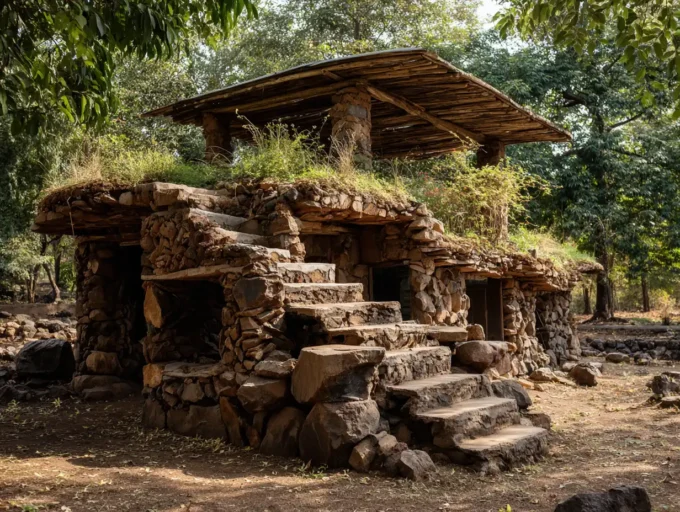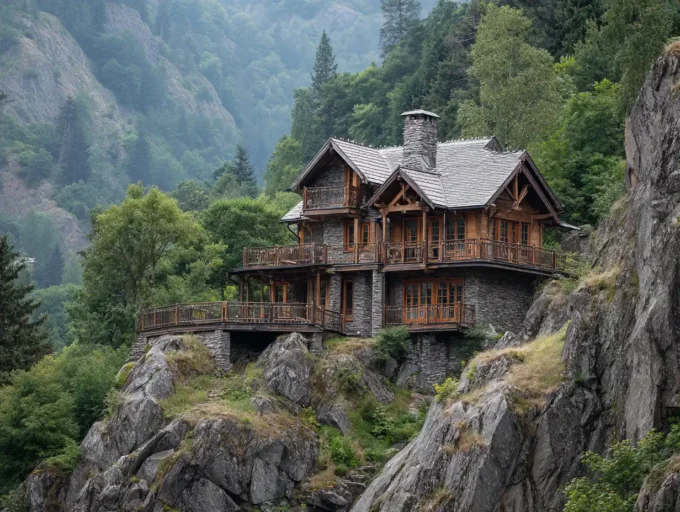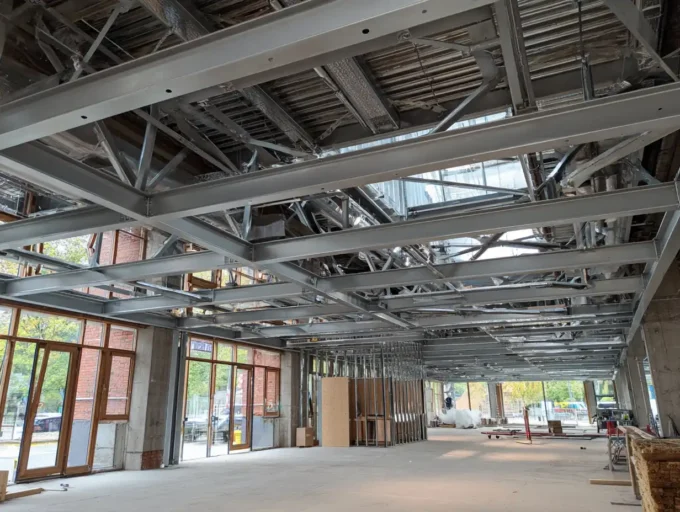A decade ago, “wood” meant studs, joists, and finish carpentry. Today, it’s shaping offices, schools, and mid‑ to high‑rise housing. In this piece, we unpack how wood is changing modern construction, technically, economically, and experientially, drawing on what we’ve seen across recent mass timber projects and the broader market shift.
From Commodity To Engineered Material: The Rise Of Mass Timber
Cross-Laminated Timber, Glulam, And LVL Explained
Mass timber isn’t your grandfather’s 2x framing. Cross‑laminated timber (CLT) panels stack perpendicular layers of boards, glued to act like wide, stiff plates, great for floors, roofs, and walls. Glue‑laminated timber (glulam) builds up dimensional lumber into deep beams and columns with high strength and graceful spans. Laminated veneer lumber (LVL) uses thin veneers in a single orientation for very high, predictable strength, ideal for headers, rim beams, and composite systems. We often combine them: glulam columns and beams with CLT floor plates, or LVL ribs under CLT for longer spans.

How Mass Timber Differs From Light-Frame Wood
Light‑frame wood relies on many small members and sheathing: it’s efficient for low‑rise but can be tricky for vibration, acoustics, and fire separation at bigger scales. Mass timber swaps “lots of little” for “fewer, bigger” elements. That unlocks longer spans, better diaphragm action, and cleaner routing for MEP. It also changes our detailing: we design engineered connections with dowels, self‑tapping screws, or concealed steel to deliver moment capacity and stiffness you won’t get from typical clip angles.
Supply, Quality Control, And Global Production Trends
Quality is governed by standards such as PRG‑320 for CLT in North America and EN standards in Europe. Factory CNC fabrication tightens tolerances and reduces rework. On supply, Europe still leads output, but North American capacity has grown quickly with new lines in the Pacific Northwest, the South, and Quebec. Asia‑Pacific is scaling too. As more plants come online, lead times are improving, grades are diversifying (including hardwood CLT), and prices are stabilizing. The throughline: mass timber has become an engineered product class with reliable specs, not a bespoke novelty.
Performance And Safety: Strength, Fire, And Seismic Behavior
Fire Resistance And Charring Rates
Counterintuitive but true: large timber can perform very well in fire. When exposed, it chars at a predictable rate, commonly on the order of 0.6–0.8 mm/min (about 1.5–2.0 in/hr). The sacrificial char insulates the core, so we design members with added “char depth” to meet required fire ratings. For higher‑rise occupancies, encapsulation (gypsum) can limit fuel contribution while keeping the structure timber. Full‑scale tests supporting the 2021 IBC tall timber provisions demonstrated 2–3 hour performance with appropriate detailing and protection strategies.
Structural Capacity, Connections, And Vibration Control
Mass timber’s strength‑to‑weight ratio is a big win: we often cut foundation loads 15–25% versus concrete. The design hinge is connections, concealed steel nodes, slotted plates, and long screws that transfer moment and shear while staying inspectable. Floors are light, so vibration and acoustics matter. We target higher modal frequencies (often 8–10 Hz for offices), add composite toppings or CLT‑concrete composites where needed, and detail discontinuous finishes to keep footfall perception tight. Done right, mass timber floors feel solid and meet office lab or classroom criteria.

Seismic Ductility And Hybrid Systems
Because timber is light, base shear drops, good news for seismic forces. For ductility, we rely on energy‑dissipating connections and rocking systems: post‑tensioned CLT walls with replaceable fuses, buckling‑restrained braces coupled to glulam frames, or timber‑concrete hybrids that tune stiffness and damping. These systems have tested well on shake tables and are finding their way into mainstream design guides. The result is repairable performance after moderate events, swappable steel fuses instead of full structural overhauls.
Carbon And Circularity: Measuring Wood’s Environmental Impact
Biogenic Carbon And Life-Cycle Assessment
Wood stores biogenic carbon during growth. In life‑cycle assessment (LCA), we account for that storage, manufacturing impacts, transport, and end‑of‑life. Third‑party EPDs for CLT and glulam make comparisons apples‑to‑apples. When we model real buildings, mass timber often shows 15–40% lower embodied carbon than conventional concrete or steel baselines, especially when we optimize spans and minimize over‑specifying thicknesses.

Sourcing, Certification, And Forest Stewardship
Low‑carbon claims only hold with good forestry. We look for FSC or PEFC certification, regional sourcing to cut transport, and mills with transparent chain‑of‑custody. Thinning and salvage (e.g., beetle‑kill) can create value while improving forest health, but we still verify regeneration and biodiversity practices with suppliers.
End-Of-Life Strategies, Reuse, And Design For Disassembly
Timber is inherently reusable. We detail bolted or screwed connections, avoid wet‑set embeds where possible, and tag members for future identification. If direct reuse isn’t viable, panels can be remanufactured or, as a last resort, turned into bioenergy with energy recovery. Designing for disassembly today is what makes circularity real tomorrow.
Speed, Cost, And Labor: The Construction-Site Upside
Prefabrication, Tolerances, And Just-In-Time Logistics
Factory‑cut holes, slots, and edges mean fewer field conflicts. We’ve flown 12,000–20,000 sq ft of floor per week with a small crew and a single crane. Just‑in‑time deliveries keep sites lean, but they demand tight BIM coordination and early shop drawings. Tolerances are predictable, think millimeter‑level accuracy, so trades can prefab too.
Noise, Waste, And Site Safety Benefits
Timber sites are quieter, cleaner, and generate far less waste. That matters in urban infill with neighbors inches away. Fewer hot works, shorter crane time, and lighter lifts improve safety metrics. Crews also appreciate the ergonomics: handling panels is simply different from tying rebar in summer heat.
Cost Drivers And When Timber Pencils Out
Material unit costs can run higher than concrete, but we claw back value through speed, smaller foundations, reduced labor, and earlier revenue. Timber “pencils out” when schedules are compressed, labor markets are tight, grid layouts avoid excessive panel thickness, and owners value the exposed finish (no ceilings, fewer finishes). Early contractor involvement is the swing factor: late swaps almost always disappoint.
Design Freedom And Occupant Experience
Span And Grid Strategies For Offices, Housing, And Schools
Offices like 20–30 ft grids with 5–7 ply CLT: housing prefers tighter grids but benefits from demising‑wall alignment and repeatable stacks: schools sit in between with big commons and classroom modules. We’ll sometimes hybridize, glulam girders at 30–36 ft with CLT secondary beams, to stretch spans without heavy toppings.

Exposed Wood, Acoustics, And Wellness
People respond to wood. Exposed ceilings and columns lift perceived warmth and reduce the need for finish materials. We pair that with acoustic control, underlays, suspended baffles, or thin concrete composites, to hit STC/IC ratings. Daylight bounces off pale timber beautifully, and biophilic studies consistently link wood interiors to lower stress and higher satisfaction. It’s not marketing fluff: tenants notice.
Codes, Finance, And Market Adoption
Tall Timber Provisions And Fire Testing Pathways
The 2021 IBC introduced Types IV‑A, IV‑B, and IV‑C, enabling mass timber buildings up to roughly 18, 12, and 9 stories with specific fire‑resistance and encapsulation rules. Jurisdictions adopting the 2024 code cycle continue to refine details. Where prescriptive paths don’t fit, we’ve used performance‑based routes, full‑scale furnace tests, compartment burn modeling, and special inspections, to satisfy AHJs.

Insurance, Lender Concerns, And Procurement Models
Underwriting is catching up. We mitigate carrier concerns with documented fire strategy (during construction and in service), moisture management plans, and third‑party QA. Lenders like predictability, so design‑assist with the fabricator, early MEP coordination, and locked‑in logistics go a long way. Design‑build or integrated project delivery tends to outperform hard‑bid for mass timber because connection design and sequencing drive success.
Conclusion
Wood isn’t a nostalgic material, it’s a modern structural system. That’s how wood is changing modern construction: by delivering competitive performance, real carbon savings, faster schedules, and spaces people actually want to occupy. If we engage fabricators early, right‑size spans, and design for fire, vibration, and moisture from day one, mass timber becomes a practical, scalable option, not the exception.
- advantages of wood construction
- biophilic design with wood
- building with timber
- carbon footprint reduction in construction
- cross-laminated timber
- eco-friendly construction materials
- green building materials
- innovative wood construction techniques
- mass timber construction
- modern construction with wood
- real project wood construction
- renewable materials in construction
- Sustainable Architecture
- sustainable building materials
- timber construction case studies
- timber engineering
- timber frame buildings
- wood in construction industry
- wooden architecture
- wooden skyscrapers
















Leave a comment